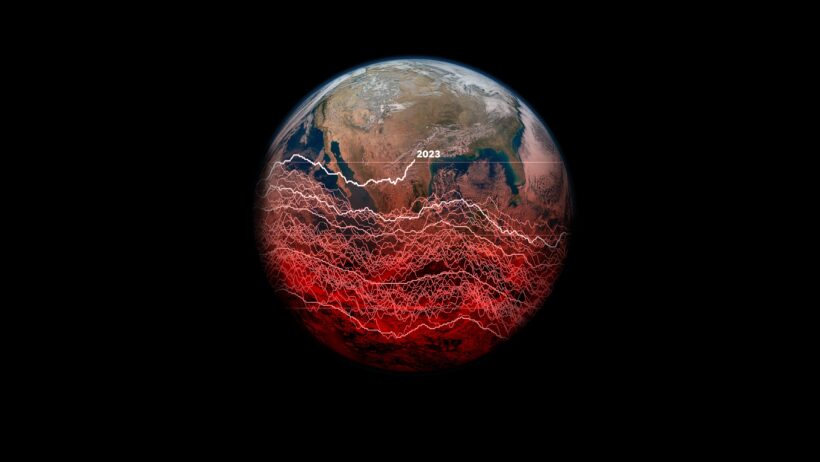The phenomenon of climate change has permeated contemporary discourse, manifesting its effects on various dimensions of human existence and the natural world. As temperatures rise and weather patterns destabilize, the repercussions are not merely abstractions; they are palpable realities that shape ecosystems, economies, and societies alike. This article delves into how climate change is affecting the Earth today, elucidating its multifaceted ramifications.
Understanding climate change necessitates an exploration of its core mechanisms. At its essence, climate change refers to the long-term alteration of temperature and typical weather patterns in a place. While the Earth has naturally fluctuated in climate over millennia, the acceleration observed since the Industrial Revolution is overwhelmingly attributed to anthropogenic activities, particularly the burning of fossil fuels, deforestation, and other practices that release copious greenhouse gases into the atmosphere.
Observations reveal stark changes that fascinate and alarm; what drives this keen interest is a confluence of inherent human curiosity and the urgency of confronting the impending challenges. The impacts of climate change are not uniform; they shape the landscape of nations differently. This discrepancy is one of its most profound characteristics. But the broader question endures: How does climate change manifest in the daily experiences of life on Earth?
Environmental Degradation and Biodiversity Loss
One of the most pronounced effects of climate change is environmental degradation, which encompasses a decline in ecosystem health and the alarming rate of biodiversity loss. Ecosystems are intricate webs of interdependent organisms, playing essential roles in the stability of environmental systems. As the climate warms, habitats are being irrevocably altered, leading to the extinction of various species. For instance, coral reefs, often referred to as the “rainforests of the sea,” are experiencing widespread bleaching due to elevated sea temperatures. This biological devastation diminishes marine biodiversity, disrupts food chains, and adversely impacts communities reliant on these ecosystems for their livelihoods.
Moreover, changes in climate patterns have precipitated alterations in migration behaviors among wildlife. Many species are shifting their ranges poleward or to higher altitudes in response to changing temperature and habitat conditions. This displacement can lead to increased competition for resources and potential conflicts between native species and newcomers, exacerbating the risks of extinction for already vulnerable populations.
Extreme Weather Events: A New Normal
The frequency and intensity of extreme weather events present another significant consequence of climate change. From unprecedented hurricanes and torrential floods to debilitating droughts and wildfires, the planet is facing a reality where such occurrences are becoming the norm rather than the anomaly. These extreme events wreak havoc on infrastructure and ecosystems alike, causing considerable economic strains on governments and communities. The economic toll, including damage to homes, businesses, and agriculture, is staggering, often leaving regions grappling with long-term recovery while also incurring heavy environmental costs.
In many instances, vulnerable populations, particularly in developing regions, bear the brunt of these disasters. Marginalized communities often lack the resources to rebound from such catastrophes, leading to exacerbated inequalities. The interplay between socioeconomic disparities and environmental vulnerabilities highlights a critical aspect of climate change: its capacity to amplify existing societal fractures.
Persistent Public Health Challenges
As climate change reshapes the natural world, it also engenders persistent public health challenges. The interlinkages between climate conditions and health outcomes are becoming increasingly evident. Rising temperatures can exacerbate air quality issues, contributing to respiratory ailments and cardiovascular diseases. Additionally, the proliferation of disease vectors, such as mosquitoes, is influenced by climate variations. Regions historically unaffected by diseases like malaria or dengue fever now find themselves at risk due to climate-induced changes, further stressing public health systems.
Food Security and Agricultural Disruptions
Climate change is inextricably linked to food security, with agricultural systems facing myriad stresses from changing climatic patterns. Crop yields can be significantly influenced by variations in temperature and precipitation. While some regions may experience an initial surge in productivity, many others are faced with diminishing returns due to increased frequency of droughts, floods, and pest infestations. This duality poses a critical dilemma for food security, endangering the livelihoods of farmers and exacerbating hunger in already compromised areas.
The agricultural sector must adapt to novel climate realities, which includes adopting resilient practices and innovative technologies. However, large-scale implementation of these strategies is often hindered by economic constraints and policy inertia. Thus, ensuring food security in a climate-changed world necessitates concerted efforts from multiple stakeholders, including governments, NGOs, and private sectors.
In Conclusion: The Imperative for Collective Action
Climate change is a multidimensional issue, with impacts reverberating across ecosystems, economies, and societies. The urgency of addressing these challenges cannot be overstated; proactive measures towards mitigation and adaptation must be prioritized. Cutting greenhouse gas emissions, investing in renewable energy, enhancing community resilience, and fostering conservation efforts are paramount steps we must undertake collectively. The pressing nature of climate change serves as both a call to action and an opportunity for humanity to foster deeper connections with the planet, ultimately safeguarding it for future generations.






